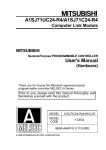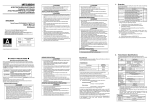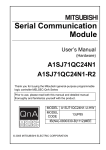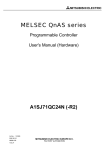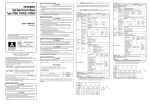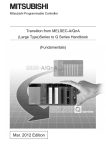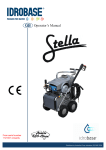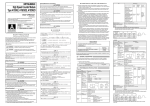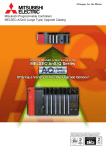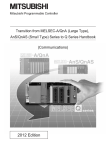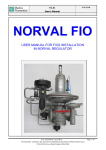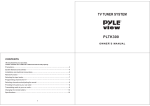Download A1SJ71UC24-R4/A1SJ71C24-R4 Computer Link Module
Transcript
A1SJ71UC24-R4/A1SJ71C24-R4 Computer Link Module MITSUBISHI General-Purpose PROGRAMMABLE CONTROLLER User's Manual (Hardware) Thank you for buying the Mitsubishi general-purpose programmable controller MELSEC-A Series. Prior to use, please read this manual thoroughly and familiarize yourself with the product. MODEL A1SJ71C24-R4(H/W)U-E MODEL CODE 13JE52 IB(NA)-66491-D (0902) MEE ©1998 MITSUBISHI ELECTRIC CORPORATION SAFETY PRECAUTIONS (Read these precautions before using.) When using Mitsubishi equipment, thoroughly read this manual and the associated manuals introduced in the manual. Also pay careful attention to safety and handle the module properly. These precautions apply only to Mitsubishi equipment. Refer to the CPU module user’s manual used for a description of the programmable controller system safety precautions. These SAFETY PRECAUTIONS classify the safety precautions into two categories: "DANGER" and "CAUTION". DANGER CAUTION Procedures which may lead to a dangerous condition and cause death or serious injury if not carried out properly. Procedures which may lead to a dangerous condition and cause superficial to medium injury, or physical damage only, if not carried out properly. Depending on circumstances, procedures indicated by CAUTION may also be linked to serious results. In any case, it is important to follow the directions for usage. Store this manual in a safe place so that you can take it out and read it whenever necessary. Always forward it to the end user. [DESIGN PRECAUTIONS] DANGER • When performing the control of the programmable controller in operation (especially changing data, program and operation status (Remote RUN/STOP)) by connecting a personal computer, etc. to the special function module, configure an interlock circuit in a sequence program so the safety of the overall system is always maintained. Particularly in the above described control for a remote site programmable controller from an external device, troubles occurring on the programmable controller side may not be immediately handled due to a data communication error. Construct an interlock circuit in the sequence program and determine between the external device and programmable controller CPU the system's error handling procedure and other items regarding data communication errors. CAUTION • Do not bunch the control wires or communication cables with the main circuit or power wires, or install them close to each other. They should be installed 100 mm (3.9 inch) or more from each other. Not doing so could result in noise that would cause malfunction. [INSTALLATION PRECAUTIONS] CAUTION • Use the programmable controller in the environment given in the general specifications section of the applicable User's Manual for the CPU module used. Using this programmable controller in an environment outside the range of the general specifications could result in electric shock, fire, malfunction, and damage to or deterioration of the product. • Shut off the external power supply for the system in all phases before wiring. If you do not switch off the external power supply, it will cause electric shock or damage to the product. • Insert the tabs at the bottom of the module into the mounting holes in the base module, and tighten the module installation screws with the specified torque. If the module is not properly installed it may result in malfunction, failure or fallout. • Tighten the screw within the range of specified torque. If the screw are loose, it may result in fallout, short circuit or malfunction. Tightening the screws too far may cause damage to the screw and /or the module, resulting in fallout, short circuit or malfunction. • Do not directly touch the module's conductive parts or electronic components. Doing so could cause malfunction or failure in the module. • Perform correct pressure-displacement, crimp-contact or soldering for wire connections using the tools specified by the manufactures. Attach connectors to the module securely. [WIRING PRECAUTIONS] CAUTION • Be sure that the communication cable connected to the module is kept in a duct or fixed with cramps. Failure to do so may cause a damage to the module or cables due to dangling, shifting or inadvertent handling of cables, or misoperation because of bad cable contacts. • Before connecting the cables, check the type of interface to be connected. Connection, or erroneous wiring to the wrong interface may damage the module and external device. • When connecting an external device to RS-422 interface of this module, do not connect a device that must receive power from this module. The module or external device may be damaged. • Tighten the terminal screw within the range of specified torque. If the screws are loose it may result in short circuit or malfunction. Tightening the screws too far may cause damage to the screw and/or the module, resulting in fallout, short circuit or malfunction. • Do not grab on the cable when removing the communication cable connected to the module. When removing the cable without connector, loose the screw on the side that is connected to the module. Pulling the cable that is still connected to the module may cause malfunction or damage to the module or cable due to bad cable contacts. • Be sure there are no foreign substances such as sawdust or wiring debris inside the unit. Such debris could cause fire, damage or malfunction. [STARTING AND MAINTENANCE PRECAUTION] DANGER • Do not touch the terminals while the power is on. Doing so may cause malfunction. • Always switch OFF the external supply power used by the system in all phases before cleaning or retightening screws. If you do not switch off the external power supply, it will cause failure or malfunction of the module. If the screws are loose, it may result in fallout, short circuit or malfunction. Tightening the screws too far may cause damage to the screws and/ or the module, resulting in fallout, short circuit or malfunction. CAUTION • Do not diassemble or modify the modules. Doing so could cause failure, malfunction, injury or fire. • Shut off the external power supply for the system in all phases before mounting or removing the module. If you do not switch off the external power supply, it will cause failure or malfunction of the module. • Before handling the module, touch a grounded metal object to discharge the static electricity from the human body. Not doing so may cause a failure or malfunction of the module. [OPERATION PRECAUTIONS] DANGER • Do not write data to the "system area" in the buffer memory of the special function module. Also, do not output (or turn on) a "use prohibited" signal from the programmable controller CPU to the special function module. If data is written to the "system area" or if the "use prohibited" signal is output, there is a risk that the programmable controller system will operate incorrectly. CAUTION • Before performing the control of the programmable controller in operation(especially changing data, program and operation status(Remote RUN/STOP)) by connecting a personal computer, etc. to the special function module, read User's Manual (Com. link func. /Print. func.) carefully and confirm if the overall safety is maintained. Failure to perform correct operations to change data, program or the status may result in system malfunction, machine damage or an accident. [DISPOSAL PRECAUTIONS] CAUTION • When disposing the product, treat it as industrial waste. About Manuals The following product manuals are available. Please use this table as a reference to request the appropriate manual as necessary. Related Manuals Manual No. (Model Code) Manual Names Computer Link Module Guide Book SH-3510 (13JE76) Computer Link Module (Com. link func. /Print. func.) User’s Manual SH-3511 (13JE77) When using this module, be sure to read Computer Link Module User's Manual (Com. link func. /Print. func.) as well as this manual. A1SJ71UC24-R4 computer link function is the same as AJ71UC24. When you refer to the following manual to use A1SJ71UC24-R4, replace the module model name to refer. Computer Link Module User's Manual (Com. link func. /Print. func.) ...................................... Version C or before AJ71UC24 → A1SJ71UC24-R4 Conformation to the EMC Directive and Low Voltage Instruction For details on making Mitsubishi programmable controller conform to the EMC directive and low voltage instruction when installing it in your product, please see Chapter 3, "EMC Directive and Low Voltage Instruction" of the User's Manual (Hardware) of the programmable controller CPU to use. The CE logo is printed on the rating plate on the main body of the programmable controller that conforms to the EMC directive and low voltage instruction. By making this product conform to the EMC directive and low voltage instruction, it is not necessary to make those steps individually. 1. Overview This manual is intended for installing the computer link module and performing wiring for external devices. After unpacking the module, check that the following products are included: Model name A1SJ71UC24-R4 A1SJ71C24-R4 Item name A1SJ71UC24-R4 computer link module Terminal resistor for RS-422 communication 330 Ω 1/4 W (orange-orange-brown ) Terminal resistor for RS-485 communication 110 Ω 1/2 W (brown-brown-brown ) A1SJ71C24-R4 computer link module Terminal resistor for RS-422 communication 330 Ω 1/4 W (orange-orange-brown ) Terminal resistor for RS-485 communication 110 Ω 1/2 W (brown-brown-brown ) Quantity 1 2 2 1 2 2 * In the explanation hereafter, the computer link/multi-drop link module is abbreviated as the "C24" except when differentiate specially. * The following accesses to the programmable controller CPU with a dedicated protocol of the computer link function are possible by using A1SJ71UC24-R4. Access to the device extended by AnACPU, AnUCPU and A2US(H)CPU. Access to the other stations via MELSECNET/10. Other specifications are the same as A1SJ71C24-R4. * Differentiate the terminal resistors as follows: 330Ω Orange Orange Brown 110Ω 1 Brown Brown Brown 2. Transmission Specifications The following table indicates the transmission specifications when using the C24 computer link function. For general specifications of the UC24, see the user's manual for the CPU module used. Item Interface Transmission method Specification Conform to RS-422/485 Dedicated protocol Half duplex communication method *1 No protocol/ 1:1 Full duplex connection communication method Bidirectional 1 : n, m : n connection Synchronization system Transmission speed Data format Start bit Data bit Parity bit Stop bit Access cycle Error detection DTR/DSR control (ER/DR) DC1/DC3, DC2/DC4 control Line configuration (external device: programmable controller CPU) Transmission distance Current consumption Occupied I/O points Weight Half duplex communication method Start-stop synchronization method 300, 600, 1200, 2400, 4800, 9600, 19200 bps (Selected via the switch) 1 7 or 8 Selected via the switch 1 or none 1 or 2 Processing for one request is performed during the END processing of the sequence program. Therefore, the access cycle is one scan time. Parity check yes (odd/even) or no Sum check yes or no No Yes/No (selected by setting to the buffer memory) Dedicated protocol No protocol 1 : 1, 1 : n, m : n 1 : 1, 1 : n Bidirectional 1:1 RS-422/485 Overall distance 500m (1640 ft.) or less 5VDC 0.1A 32 points *2 0.25 kg(0.56 lb.) *1 When data communication can be performed using the full duplex transmission method, this transmission method is used whenever the on-demand function is used. *2 When performing I/O assignment using the GPP function, set as special 32 points. The model name to register when using the dedicated commands, the following model name should be set depending on C24 and programmable controller CPU mounted to C24. 2 Programmable Types of C24 to mount controller CPU mounted to C24 A1SJ71UC24-R4 A1SJ71C24-R4 AnUCPU A1SJ71UC24 AJ71C24S3 AnACPU AJ71C24S3 Other than AnU/AnACPU (Model name setting is not necessary as the dedicated command cannot be used.) 3 3. Name of Each Part and Setting A1SJ71C24-R4 1) Indicator LED's MD SW 01 02 ST.DWN MD L STATION NO. 03 04 01 456 78 9 2) Transmission specification setting switch SCAN SET E. SCAN E. SIO E. NEU ACK NAK C/N P/S PRO SIO COM 10 23 05 06 01 456 9 78 07 08 1 3) Station number setting switch 23 09 10 11 89 67 012 12 EF CD AB MODE 4) Mode setting switch 345 SDA SG SDB FG 6) RS-422/485 interface RDA NC RDB RS-422/485 A1SJ71C24-R4 Number Name 1) Indicator LEDs RUN SD RD CPU MD NEU ACK NAK C/N P/S PRO SIO COM RUN SCAN SET E. SCAN E. SIO E. ST.DWN MD L SD RD CPU MD NEU 4 * The module diagram is shown with A1SJ71C24-R4. Description Normal operation indicator Normal : lit Error : unlit Transmission status Data being transmitted : flashing Reception status Data being received : flashing Communication Status with CPU main module. Communicating with programmable controller CPU : flashing Multi-droplink Multi-droplink : lit Computer link : unit Neutral status Transmission sequence initial status (waiting for ENQ) : lit ENQ reception complete : unlit Number 1) Name Indicator LEDs (continued) RUN SD RD CPU MD NEU ACK NAK C/N P/S PRO SIO COM SCAN SET E. SCAN E. SIO E. ACK NAK ST.DWN MD L C/N P/S PRO SIO COM 5 Description ACK transmission status ACK transmitted NAK transmitted NAK transmission status NAK transmitted ACK transmitted Result of communication with programmable controller CPU Error in communication with the programmable controller CPU Normal communication Parity/sum check error Parity/sum check error Normal Protocol error Normal protocol error Normal SIO error When overrun or framing error When received data has been discarded due to OS receive area full Normal Computer link Computer link or multi-drop link (local station) Multi-drop link (master station) : lit : unlit : lit : unlit : lit : unlit : lit : unlit : lit : unlit : lit : lit : unlit : lit : unlit Number Name 2) Transmission setting switch SW 01 02 03 04 ON ON 05 06 07 08 09 10 11 12 Description Transmission settings (all are set to OFF at the time of shipment) SW Setting item Status ON OFF 01 Not used ⎯ ⎯ Computer link/multi- Computer Setting 02 drop link selection impossible link 03 A1ADP-SP setting A1ADP- A1ADP*1 SP used SP not used 04 Setting for write Enabled Disabled during RUN 05 Transmission 06 speed setting See *2 07 08 Data bit setting 8 bits 7 bits 09 Parity bit setting YES NO 10 Even/odd parity Even Odd setting 11 Stop bit setting 2 bits 1 bit 12 Sum check setting YES NO *1 This setting is available when software version of the A1SJ71UC24-R4 is X or later, and not available for the A1SJ71C24-R4. *2 Transmission speed settings Setting switch 300 600 SW05 SW06 SW07 OFF OFF OFF ON OFF OFF Transmission speed (unit: bps) 1200 2400 4800 9600 19200 OFF ON OFF 6 ON ON OFF OFF OFF ON ON OFF ON OFF ON ON Setting prohibited ON ON ON Number Name 3) Station number setting switch 7 8 0 1 4 5 6 9 ×10 Description Module station number setting (set to 00 at time of shipment) <Setting range> 00 to 31 X10 --- set the station number ten's place X1 --- set the station number unit's place 2 3 7 8 0 1 4 5 6 9 ×1 2 3 Mode setting switch 012 67 A BCD EF 89 4) MODE Mode setting (set to 0 at the time of shipment) Mode Setting contents 0 Use prohibited 1 to Use prohibited 3 4 Non procedure mode 5 Type 1 dedicated protocol mode 6 Type 2 dedicated protocol mode 7 Type 3 dedicated protocol mode 8 Type 4 dedicated protocol mode 345 9 to Use prohibited E 5) RS-422/485 interface F For module test RS-422/485 interface for external device connection 7 4. Loading and Installation This section explains precautionary items regarding handling of the C24 from unpacking up to installation, and the installation environment that are common to all modules. See the user's manual for the programmable controller CPU module used for further details regarding module loading and installation. 4.1 Precautionary Items when Handling The following explains precautionary items when handling the module: (1) Do not drop or apply severe shock to the module case since it is made of resin. (2) Tighten the module installation screws within the specified torque range as follows: Screw Area RS-422 / 485 terminal block terminal screws (M3.5 screw) Module installation screws (M4 screw) Tightening Torque Range 59 to 88N • cm (5.2 to 7.8lb • inch) 78 to 118N • cm (6.9 to 10.4lb • inch) RS-422 / 485 terminal block installation screws 49 to 78N • cm (M3.5 screw) (4.3 to 6.9lb • inch) 8 4.2 Installation Environment Avoid the following conditions for the installing location of the AnS Series programmable controller: (1) Location where the ambient temperature exceeds the range of 0 to 55 °C. (2) Location where the ambient humidity exceeds the range of 10 to 90% RH. (3) Location where condensation occurs due to a sudden temperature change. (4) Location where corrosive or inflammable gas exists. (5) Location where a lot of conductive powdery substance such as dust and iron filing, oil mist, salt, or organic solvent exists. (6) Location exposed to direct sunlight. (7) Location where strong electric fields or magnetic fields form. (8) Location where vibration or impact is directly applied to the main module. 9 5. External Wiring The standard method for connecting the RS-422/485 line is shown below: SDA SG SDB RDA NC RDB Signal Signal direction External device abbreviation C24 SDA SDB RDA RDB SG FG NC Description Transmission data Transmission data Reception data Reception data Signal ground Frame ground Vacancy (Function block diagram for the C24) SDA + Transmission data – SDB + RDA – RDB Reception data Point If the C24 serves as the first or the last station on the RS-422/485 line, connect a terminal resistor as shown below to the RS-422/485 interface according to the communication specification. When a terminal resistor is not connected, an error may result during data communication. • For RS-422 communication ...................... 330 Ω, 1/4W • For RS-485 communication ...................... 110 Ω, 1/2W (1) When an external device and the C24 are connected in 1:1 or 1:n, connect a terminal resistor between SDA and SDB as well as between RDA and RDB. (2) When an external device and C24 are connected in m:n, connect a terminal resistor between RDA and RDB. The R in the following wiring diagram represents a terminal resistor. 10 (1) Example of connecting external devices and C24 by 1:1 External device Signal name RDA RDB SDA SDB RSA RSB CSA CSB R R Cable connection and signal direction (example) C24 Signal name SDA SDB RDA RDB R R NC SG FG SG FG (2) Example of connecting external devices and C24 by 1:n * Connecting external devices and C24 modules via RS-485 External device R R RS-485 RS-485 Station 0 C24 RS-485 Station 1 C24 Station n C24 SDA SDA SDA SDB SDB SDB SDB RDA RDA RDA RDA SDA RDB RDB RDB RDB SG SG SG SG FG FG FG FG R R (3) Example of connecting external devices and C24 by m:n * Connecting external devices and C24 modules via RS-485 External device External device SDA SDB RDA RDB SG FG SDA SDB RDA RDB SG FG Station 0 C24 Station 1 C24 Station n C24 SDA SDB RDA RDB SG FG SDA SDB RDA RDB SG FG SDA SDB RDA RDB SG FG 11 (4) Countermeasure for data reception errors in the external device with the RS-422 or RS-422/485 connection During data communication with external devices via C24 RS422/485 interface , if there is a possibility that the external device receives an error data, install pull-up and pull-down resistors to the external device side (about 4.7kΩ, 1/4 W as a reference of resistor value). Installation of pull-up and pull-down resistors will prevent data reception errors. RDA RDB 4.7kΩ1/4W + Reception data Terminal resistor – 4.7kΩ1/4W External device Point Installation of pull-up and pull-down resistors will prevent data reception errors. Remarks The following explains the case in which pull-up and pull-down resistors are not installed to the external device: 1) When none of the stations are receiving, the transmission line is in a state of high impedance, causing the transmission line to become unstable due to noise and a possibility that the data will be received incorrectly at the external device. When this happens, a parity error or framing error is likely to occur. Therefore, skip the data when the error has occurred. 2) For data communication using the dedicated protocol, the first data will be determined based on the format used by the user. Skip the data received prior to the first data as determined. 12 (5) Precautionary items when wiring 1) When connecting the SG and FG signals of the C24 to an external device, follow the specification of the external device. 2) If data communication cannot be performed normally due to external noise even if the wiring is done according to this section, perform wiring as follows: (Connect nnA and nnB in each signal of the connector cable as a pair.) (C24) * Shield (Opposite device) SDA RDA SDB RDB RDA SDA RDB SDB SG SG FG FG When data communication cannot be performed normally even if this wiring is done, connect the connector cable shield to either one of the FG terminals on the connected device. (when connect to the external device, refer to the handling manual of the external device.) Point (1) In the explanation of the terminal resistor setting/connection in this section, when an RS-232C - RS-422 converter or other equipment is used for the device which serves as either of the line terminating stations, setting and wiring for a terminal resistor is required on the converter (or the equipment). (2) The devices connected to the C24's RS-422/RS485 interface must use all RS-422 or all RS-485, including 1:n and m:n connections. 13 6. External Dimensions A1SJ71C24-R4 MD SCAN SET E. SCAN E. SIO E. NEU ACK NAK C/N P/S PRO SIO COM SW 01 02 03 ST.DWN MD L STATION NO. 10 4 01 56 78 9 04 23 05 06 4 1 01 56 78 9 07 08 09 10 11 12 23 89 67 01 EF 2 CD AB MODE 130 (5.12) 27 (1.06) RUN SD RD CPU 345 SDA SG SDB R1 r1 RDA NC RDB RS-422/455 A1SJ71C24-R4 71.6 (2.82) 6.5 (0.26) 93.6 (3.69) 22 (0.87) 34.5 (1.36) (unit: mm (inch)) R1 (Bending radius near terminal block) : r1 (Bending radius near crimp contact) : Cable diameter × 4 Can be connected in a range without extreme bend External dimensions of A1S71UC24-R4 and A1SJ71C24-R4 are the same. The diagram above is of A1SJ71UC24-R4 external dimensions. 14 Country/Region Sales office/Tel Country/Region Sales office/Tel U.S.A Mitsubishi Electric Automation Inc. Hong Kong Mitsubishi Electric Automation (Hong Kong) Ltd. 500 Corporate Woods Parkway Vernon 10th Floor, Manulife Tower, 169 Electric Hills, IL 60061, U.S.A. Road, North Point, Hong Kong Tel : +1-847-478-2100 Tel : +852-2887-8870 Brazil MELCO-TEC Rep. Com.e Assessoria China Mitsubishi Electric Automation Tecnica Ltda. (Shanghai) Ltd. Rua Correia Dias, 184, 4/F Zhi Fu Plazz, No.80 Xin Chang Road, Edificio Paraiso Trade Center-8 andar Shanghai 200003, China Paraiso, Sao Paulo, SP Brazil Tel : +86-21-6120-0808 Tel : +55-11-5908-8331 Taiwan Setsuyo Enterprise Co., Ltd. Germany Mitsubishi Electric Europe B.V. German 6F No.105 Wu-Kung 3rd.Rd, Wu-Ku Branch Hsiang, Taipei Hsine, Taiwan Gothaer Strasse 8 D-40880 Ratingen, Tel : +886-2-2299-2499 GERMANY Korea Mitsubishi Electric Automation Korea Co., Ltd. Tel : +49-2102-486-0 1480-6, Gayang-dong, Gangseo-ku U.K Mitsubishi Electric Europe B.V. UK Seoul 157-200, Korea Branch Tel : +82-2-3660-9552 Travellers Lane, Hatfield, Hertfordshire., Singapore Mitsubishi Electric Asia Pte, Ltd. AL10 8XB, U.K. 307 Alexandra Road #05-01/02, Tel : +44-1707-276100 Mitsubishi Electric Building, Italy Mitsubishi Electric Europe B.V. Italian Singapore 159943 Branch Tel : +65-6470-2460 Centro Dir. Colleoni, Pal. Perseo-Ingr.2 Thailand Mitsubishi Electric Automation (Thailand) Via Paracelso 12, I-20041 Agrate Brianza., Co., Ltd. Milano, Italy Bang-Chan Industrial Estate No.111 Tel : +39-039-60531 Moo 4, Serithai Rd, T.Kannayao, Spain Mitsubishi Electric Europe B.V. Spanish A.Kannayao, Bangkok 10230 Thailand Branch Tel : +66-2-517-1326 Indonesia P.T. Autoteknindo Sumber Makmur Carretera de Rubi 76-80, Muara Karang Selatan, Block A/Utara E-08190 Sant Cugat del Valles, No.1 Kav. No.11 Kawasan Industri Barcelona, Spain Pergudangan Jakarta - Utara 14440, Tel : +34-93-565-3131 P.O.Box 5045 Jakarta, 11050 Indonesia France Mitsubishi Electric Europe B.V. French Tel : +62-21-6630833 Branch India Messung Systems Pvt, Ltd. 25, Boulevard des Bouvets, F-92741 Electronic Sadan NO:III Unit No15, Nanterre Cedex, France M.I.D.C Bhosari, Pune-411026, India TEL: +33-1-5568-5568 Tel : +91-20-2712-3130 South Africa Circuit Breaker Industries Ltd. Australia Mitsubishi Electric Australia Pty. Ltd. Private Bag 2016, ZA-1600 Isando, 348 Victoria Road, Rydalmere, South Africa N.S.W 2116, Australia Tel : +27-11-928-2000 Tel : +61-2-9684-7777 HEAD OFFICE : TOKYO BUILDING, 2-7-3 MARUNOUCHI, CHIYODA-KU, TOKYO 100-8310, JAPAN NAGOYA WORKS : 1-14, YADA-MINAMI 5-CHOME, HIGASHI-KU, NAGOYA, JAPAN When exported from Japan, this manual does not require application to the Ministry of Economy, Trade and Industry for service transaction permission. Specifications subject to change without notice. Printed in Japan on recycled paper.
























